REACT: Recruiting Tomorrow's Chemists Today Via Fun, Hands-On Activities
March 17, 2017

REACT board member, Meha Akella (left), and a visitor to the Barkstall STEM Night play in Oobleck.
If you happen to visit a local 2nd, 3rd, or 4th grade classroom and find the students doing an engaging, hands-on activity about chemistry, it’s probably being led by members of REACT (Reaching and Educating America's Chemists of Tomorrow). Chemistry's student outreach group, which specializes in engaging hands-on activities and demonstrations, can be found in local classrooms, school STEM nights, and other community outreach events, showing learners of all ages that Chemistry is fun and exciting.
Surprisingly, although REACT is about chemistry, it’s not just chemistry students who are involved. Students from across a number of disciplines get involved in the organization as freshmen to fulfill requirements for the James Scholar program…then end up staying on because they find it so fulfilling.
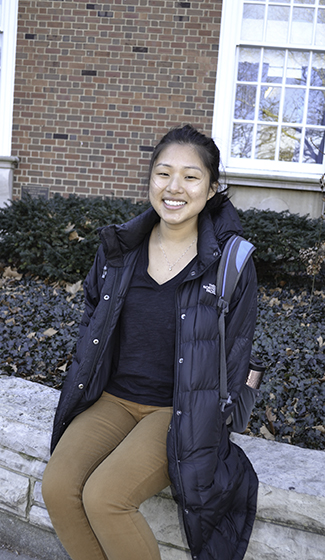
REACT president Angela Hyon.
For instance, Angela Hyon, a junior majoring in Anthropology, got involved her freshman year as a typical James Scholar student. She recalls that, as a premed student, she initially got into REACT because of the chemistry courses, and, “One thing led to another.”
“I really liked what we stood for,” Hyon continues, “inspiring students and teaching them that STEM is not all just math and stress and numbers. It can be fun when you can see reactions actually happening.”
She also finds it rewarding to expose today’s kids to something she would have loved, but didn't have access to, as a youngster. “I know, when I was around their age, I didn’t have a program like this. Actually attending those programs as a volunteer, you can see their eyes light up and how excited they are about learning more about chemistry. I think that is initially why I began."
Hyon says she became a coordinator because she “wanted to help improve the program, expand it.” And as she said, “One thing led to another.” And now she’s the president of REACT.
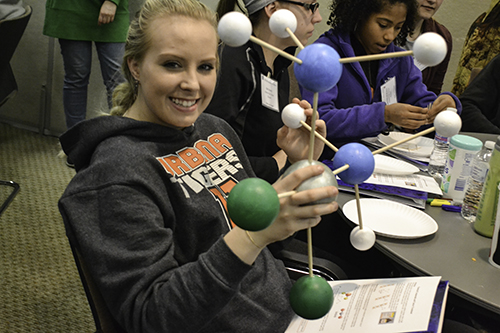
As part of REACT's hands-on activity at I-STEM's DNA Day in February 2017, an Urbana High student prepares to replicate the model of a molecule that she's holding using toothpicks and gumdrops.
REACT began in 2002, working mainly with elementary schools, but they’re now trying to expand more into middle schools and high schools. For instance, they recently participated in I-STEM’s DNA Day for Urbana High School students.
Also, because they’re expanding their services, school visits are being adapted to meet the various schools’ needs. According to Hyon, they’re doing more than ten visits this semester to a local second grade classroom, and also to Lincoln Trail Elementary School in Mohomet. REACT also participated in EOH this year, in part to highlight their sponsorship with Shell.
Although the bulk of REACT members still get involved initially to meet James Scholar requirements, the group also gets a large number of volunteers. “I think through the actual experience of volunteering, that’s how they get in,” Hyon explains.
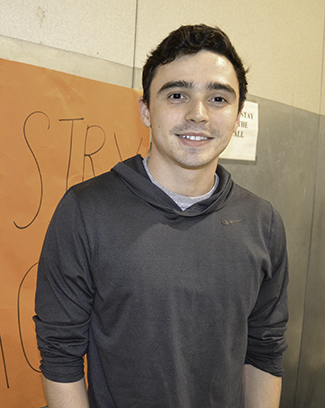
REACT member Connor McCloskey, who was on hand to help visitors to Barkstall STEM Night do several STEM-related activities.
Take Connor McCloskey, a sophomore studying computer science. Needing a freshman chemistry class, when he heard about the REACT program via a roommate, he told himself, “I guess I’ll do it.” And once he had gotten involved, he was hooked.
“I originally did it the first semester for James Scholar credit, but I’ve been volunteering ever since,” he admits.
McCloskey recently participated in REACT’s outreach at Barkstall’s STEM Night, which he found to be rewarding. “I’ve never actually been in this kind of setting. I’ve always done 3rd or 4th grade classroom visits, which I’m more used to. But, yeah, I decided to do one of these, and it has been a lot of fun so far.”
According to McCloskey, kids tend to find the REACT activities intriguing: “They always seem to be interested or fascinated, especially with chemistry,” he continues. “The study of change is something that really hooks the kids.”
And like the organization’s name implies, McCloskey also feels like he’s helping recruit some of tomorrow’s Chemists:“I really feel like I can almost pick out the kids that are definitely going to be doing something in the science field, because they seem to love this.”
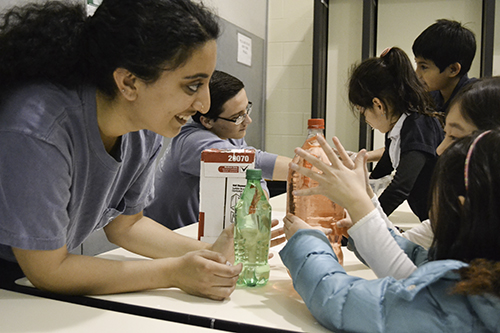
REACT board member, Meha Akella, interacts with young visitors to the Barkstall School's recent STEM Night.
REACT board member, Meha Akella, a sophomore majoring in biochemistry, says one reason REACT is so effective is that it exposes youngsters to different aspects of science than they might get in school: “They don’t really get to experience the more fun side of chemistry, ” she says. So REACT, through a variety of hands-on activities, has figured out how to pique kids’ interest in science. And like McCloskey, Akella sees it as a way of recruiting for the future. “We always can use more scientists and engineers out there,” she admits.
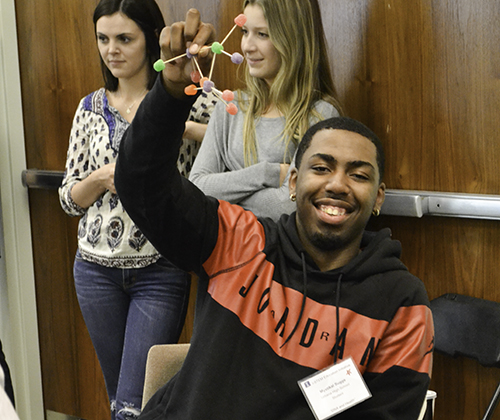
A UHS student shows off the molecule he made during REACT's hands-on activity on I-STEM's DNA Day.
Along with changing some of their outreach strategies, REACT has also seen some changes in faces and places. For instance, Dr. Tina Huang, an instructor in Chemistry, came on board last spring as the organization’s new faculty advisor. No slouch herself when it comes to chemistry demos, Huang has participated in Chemistry’s Holiday Magic show for the past several years.
REACT also just got new digs in the brand-spanking-new Chemistry Annex building which has been under construction for the past two and a half years. According to Hyon, “We used to be in a very small closet!” Now REACT shares a lab, and has their own office, which she calls “really nice and convenient. I feel like we’re on the move to expanding and to see where this program can go.”
Email REACT
Story and photographs by Elizabeth Innes, Communications Specialist, I-STEM Education Initiative.
For more articles about Chemistry and REACT, see:
- Chemistry's Holiday Magic Show Does a Bang-Up Job Saying, “Merry Christmas!”
- Barkstall STEM Night Exposes Students and Their Families to Fun Science and Engineering
- REACT: Reaching and Educating Tomorrow's Chemists Today
More: Chemistry, K-6 Outreach, K-12 Outreach, Orpheum, REACT, 2017
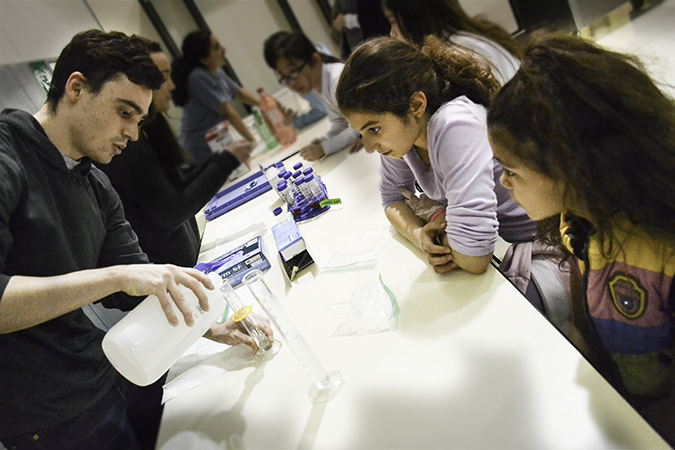
REACT member Connor McCloskey (left), a sophomore in computer engineering, helps two visitors to Barkstall's recent STEM Night make silly putty.













.jpg)
















